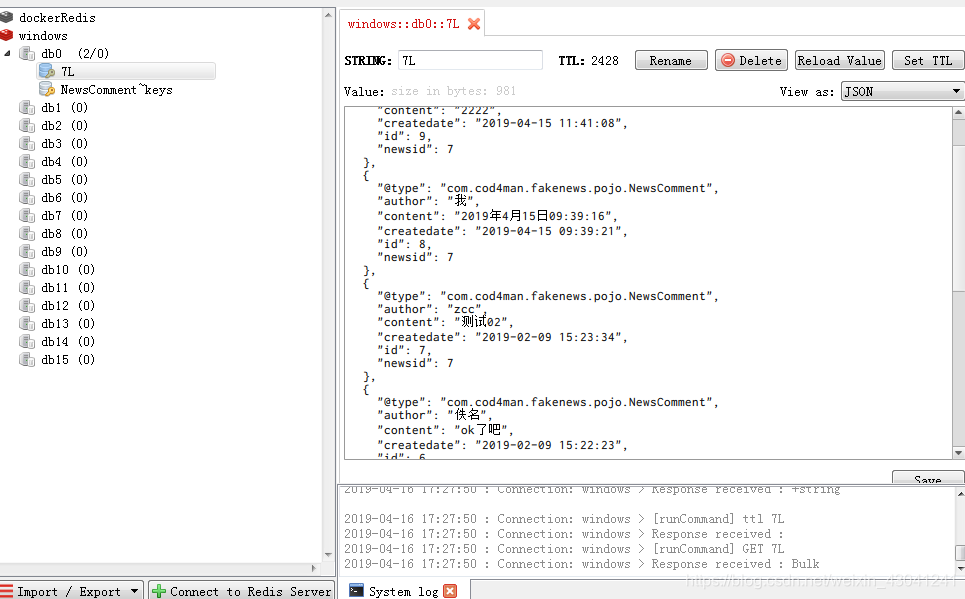首先,需要导入依赖,在SSM的基础上还需引入redis的依赖
<!-- redis cache related.....start -->
<dependency>
<groupId>org.springframework.data</groupId>
<artifactId>spring-data-redis</artifactId>
<version>1.6.0.RELEASE</version>
</dependency>
<dependency>
<groupId>redis.clients</groupId>
<artifactId>jedis</artifactId>
<version>2.7.3</version>
</dependency>
<!-- redis cache related.....end -->
将redis交给spring管理,在applicationContext.xml中引入Bean
<!-- 配置RedisCacheConfig,命令规则以及自定义缓存设定 -->
<bean id="redisCacheConfig" class="com.cod4man.fakenews.util.RedisCacheConfig">
<constructor-arg ref="jedisConnectionFactory" />
<constructor-arg ref="redisTemplate" />
<constructor-arg ref="redisCacheManager" />
</bean>
<!-- redis config end -->
其中RedisCacheConfig为自定义类,代码如下:(需要继承CachingConfigurerSupport ,可以重写KeyGenerator来自定义键名称)
package com.cod4man.fakenews.util;
/**
* Created with IntelliJ IDEA.
*
* @author 张鸿杰
* Date:2019-04-16
* Time:11:53
*/
import org.springframework.cache.annotation.CachingConfigurerSupport;
import org.springframework.cache.annotation.EnableCaching;
import org.springframework.cache.interceptor.KeyGenerator;
import org.springframework.context.annotation.Bean;
import org.springframework.context.annotation.Configuration;
import org.springframework.data.redis.cache.RedisCacheManager;
import org.springframework.data.redis.connection.jedis.JedisConnectionFactory;
import org.springframework.data.redis.core.RedisTemplate;
import java.lang.reflect.Method;
/**
* 通过spring管理redis缓存配置
*
* @author Administrator
*
*/
@Configuration
@EnableCaching //开启spring缓存注解
public class RedisCacheConfig extends CachingConfigurerSupport {
private volatile JedisConnectionFactory jedisConnectionFactory;
private volatile RedisTemplate<String, String> redisTemplate;
private volatile RedisCacheManager redisCacheManager;
public RedisCacheConfig() {
super();
}
/**
* 带参数的构造方法 初始化所有的成员变量
*
* @param jedisConnectionFactory
* @param redisTemplate
* @param redisCacheManager
*/
public RedisCacheConfig(JedisConnectionFactory jedisConnectionFactory, RedisTemplate<String, String> redisTemplate,
RedisCacheManager redisCacheManager) {
this.jedisConnectionFactory = jedisConnectionFactory;
this.redisTemplate = redisTemplate;
this.redisCacheManager = redisCacheManager;
}
public JedisConnectionFactory getJedisConnecionFactory() {
return jedisConnectionFactory;
}
public RedisTemplate<String, String> getRedisTemplate() {
return redisTemplate;
}
public RedisCacheManager getRedisCacheManager() {
return redisCacheManager;
}
@Bean //重写了key的命令规则
public KeyGenerator customKeyGenerator() {
return new KeyGenerator() {
@Override
public Object generate(Object target, Method method, Object... objects) {
StringBuilder sb = new StringBuilder();
sb.append(target.getClass().getName());
sb.append(method.getName());
for (Object obj : objects) {
sb.append(obj.toString());
}
return sb.toString();
}
};
}
}
RedisCacheConfig 该类中,需要三个参数
- JedisConnectionFactory:redis连接工厂,用来初始化一个redis连接参数以及创建RedisTemplate
- RedisTemplate<String, String> :redis模板,可以用来获取一些redis的操作方法,以及定义redis缓存序列化器,创建缓存管理器
- RedisCacheManager:redis缓存管理器,定义一些缓存设置(如缓存过期时间)等
配置RedisCacheManager:
<!-- 配置RedisCacheManager -->
<bean id="redisCacheManager" class="org.springframework.data.redis.cache.RedisCacheManager">
<constructor-arg name="redisOperations" ref="redisTemplate" />
<!--缓存过期时间-->
<property name="defaultExpiration" value="${redis.expiration}" />
</bean>
配置RedisTemplate(重写了默认序列化器为fastjson):
<!-- 配置RedisTemplate -->
<bean id="redisTemplate" class="org.springframework.data.redis.core.RedisTemplate">
<property name="defaultSerializer" ref="newsCommentFastJsonRedisSerializer"/>
<property name="connectionFactory" ref="jedisConnectionFactory"/>
</bean>
<!--配置fastjsonSerializalizer-->
<bean id="newsCommentFastJsonRedisSerializer" class="com.cod4man.fakenews.util.FastJsonRedisSerializer">
<constructor-arg name="chartset" value="UTF-8"/>
</bean>
FastjsonSerializalizer序列化器:
package com.cod4man.fakenews.util;
import com.alibaba.fastjson.JSON;
import com.alibaba.fastjson.parser.ParserConfig;
import com.alibaba.fastjson.serializer.SerializerFeature;
import org.springframework.data.redis.serializer.RedisSerializer;
import org.springframework.data.redis.serializer.SerializationException;
import java.nio.charset.Charset;
/**
* Created with IntelliJ IDEA.
*
* @author 张鸿杰
* Date:2019-04-15
* Time:20:24
*/
public class FastJsonRedisSerializer<T> implements RedisSerializer<T> {
private Charset DEFAULT_CHARSET ;
public FastJsonRedisSerializer() {
DEFAULT_CHARSET = Charset.forName("UTF-8");
}
/**
* 可自定义反序列化编码,默认为UTF-8
* @param chartset 字符编码
* @return
* @author zhj
* @creed: Talk is cheap,show me the code
* @date 2019/4/16
*/
public FastJsonRedisSerializer(String chartset) {
DEFAULT_CHARSET = Charset.forName(chartset);
}
static {
//开启AutoType
ParserConfig.getGlobalInstance().setAutoTypeSupport(true);
// ParserConfig.getGlobalInstance().addAccept("com.codeman");
}
@Override
public byte[] serialize(T t) throws SerializationException {
if (t == null) {
return new byte[0];
}
try {
return JSON.toJSONBytes(t, SerializerFeature.WriteClassName);
} catch (Exception ex) {
throw new SerializationException("Could not write JSON: " + ex.getMessage(), ex);
}
}
@Override
public T deserialize(byte[] bytes) throws SerializationException {
String data = new String(bytes, DEFAULT_CHARSET);
T result = (T) JSON.parse(data);
return result;
}
}
配置JedisConnectionFactory:
<!-- 配置JedisPoolConfig实例 -->
<bean id="poolConfig" class="redis.clients.jedis.JedisPoolConfig">
<property name="maxIdle" value="${redis.maxIdle}" />
<property name="maxTotal" value="${redis.maxActive}" />
<property name="maxWaitMillis" value="${redis.maxWait}" />
<property name="testOnBorrow" value="${redis.testOnBorrow}" />
</bean>
<!-- 配置JedisConnectionFactory -->
<bean id="jedisConnectionFactory"
class="org.springframework.data.redis.connection.jedis.JedisConnectionFactory">
<property name="hostName" value="${redis.host}" />
<property name="port" value="${redis.port}" />
<!-- <property name="password" value="${redis.pass}" /> -->
<property name="database" value="${redis.dbIndex}" />
<property name="poolConfig" ref="poolConfig" />
</bean>
Service使用注解@cachable()
@Cacheable(cacheNames = "NewsComment")
@Override
public List<NewsComment> findCommentsByNewsId(long newsId) {
System.out.println("查看什么");
return newsCommentMapper.findCommentsByNewsId(newsId);
}
http://localhost:8080/news.do/commentView/7 //查询7号新闻评论
控制台:
查看什么//只有首次查询显示
Redis仓库:显示为json格式数据

虽然使用Spring注解来指定缓存非常方便,但是想要进行非常详细、系统的设计缓存数据结构,仅仅使用自带注解还是完全不够的。我的下一篇博客,将会使用自定义注解来详细的定制缓存数据结构:
https://blog.csdn.net/weixin_43041241/article/details/89345139
·
·
·
·
·
·
·
···
·
··
·
参考: https://blog.csdn.net/moshowgame/article/details/83246363
http://www.cnblogs.com/hello-daocaoren/p/7891907.html